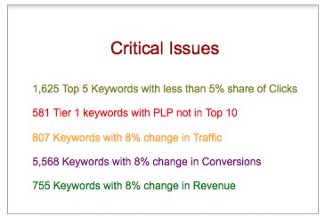That was the goal of Dataprizm, which is why we named it such. By storing and organizing data, we could look through it through different lenses and find the opportunity that was being missed.
For the past few weeks, I have regretted shutting down DataPrizm nearly every day. Integrating the current power of AI and Natural Language Processing would have made it exponentially more valuable. DataPrizm radically changed how several companies managed, monitored, and mined consumer insights into a collaborative data-driven ecosystem.
Compiling all client-supplied revenue and savings estimates, we believe we generated over $100 million in value for clients. For one company specifically, we identified and helped them capture over $580 million in untapped opportunities by mining and analyzing gaps.
The application was a cloud-based data storage and mining system with 50 dynamic mining functions, enabling companies to quickly identify opportunities from their keyword and website performance data.
DataPrizm solved
- The storage and mining of large-scale keyword lists and associated data is a challenge and, for larger companies, virtually impossible. This application enables scale and data queries that marketers can use for content creation, paid search targeting, and social media conversational mining.
- Search engines, especially Google, have moved to surfacing content that best answers the needs and interests of the searcher. Simply creating content for specific keywords no longer works, and companies need to better understand the voice of the consumer via their search words. By aligning keywords to interest/intent, buy cycle, and personas, businesses can stay ahead of Google and continue to yield significant opportunities.
30 Minutes to Search Greatness
I used That subject line for an email I sent to our first paying customer for DataPrizm. I told them the system did its filters and presented them on the login screen.

I told them I had spent 30 minutes looking at these 5 reports and trying to find some quick wins.
I finished the email with Wrap Up:
It took about 30 minutes to scan each analysis, review the poor-performing phrase, ad, and/or page, decide what to do, and document the results. Unfortunately, we can’t push a button to fix them. Still, we have identified opportunities to prioritize resources to fix them, where they will increase traffic and revenue or save money on Paid Search media costs. Your highest Cost Per Click keyword cost 191,300.02 in clicks but only generated $7474.91 in revenue. Conversely, in organic search this phrase ranked #1 and generated $6 million in revenue. Suggest pausing this phrase to evaluate if the paid click revenue shifts to organic.
Simply fixing five negative ROI PPC keywords should save as much as $20,000, and the increased traffic from the organic performance can be five to ten times that if done correctly and quickly. This was a quick review and if done properly, with a more comprehensive analysis, significant incremental opportunity can be realized for Travelocity.
Why did DataPrizm not become a mission-critical solution?
If Dataprizm was this fantastic tool that identified opportunities, why was it not adopted by everyone?
Unwanted Insights – In most cases, we identified significant inefficiencies and other issues by teams and agencies. Ironically, the first outside investor themselves stopped their participation because it showed multiple errors in judgment by the CMO and their agencies on paid search spend, which they did not appreciate. Numerous times, we were told by the initial contacts that the insights would most likely get them fired, and they backed away from the tool.
Just a Keyword Tool – that is how many thought of it. For example, for an international bank, we got an audience with the global CMO and opportunities team. Working with a couple of brand strategy consultants, we presented our initial insights on how they could identify small and medium businesses considering international expansion. During our 3rd meeting to finalize pricing, someone asked where we got the data. We indicated one of the sources was Google’s Adwords keyword data. One of the people in the room was from the digital team and, after the meeting, told the executives he felt his “paid search agency” could do a similar report. We were then “demoted” to the search team and ultimately were not considered. Many months later, we found the agency did not do what they needed, and the momentum was lost, and they moved on from the project.
Manual Labor—Unlike today, when we could classify the terms and mine them with NLP libraries and more advanced AI tools, a fair bit of building the classification libraries and refinements were manual, requiring labor and effort from the clients that they did not want to do.
